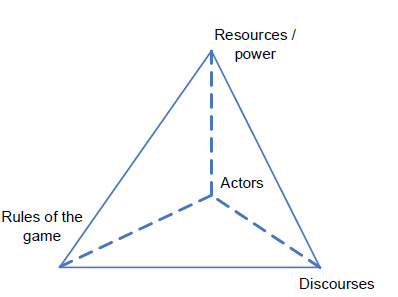Policy Arrangement Approach
A policy arrangement is one of the key concepts of the policy arrangement approach, which is developed by Van Tatenhove et al. (2000). This approach has its roots in the field of environmental policy and functions as a ‘meso level theory’ or ‘approach’ for analyzing and understanding change and stability in policy processes (Leroy and Arts, 2006). The policy arrangement approach aims at linking structural social and political changes in society to changes in the day-to-day practice of policy processes. A policy arrangement is defined as “the temporary stabilization of the content and organization of a particular policy domain at a certain policy a level or over several policy levels” (Leroy and Arts 2006). Four interrelated dimensions are used to describe the policy arrangement, three of which have an organisational or structural nature and one related to the substance of the arrangement. The organisational dimensions are (1) the actors and actor coalitions involved in the policy domain, (2) the rules and regulations (both formal and informal) that play a role and (3) the (division of) resources (e.g. money, knowledge, facilities) and related power. The substantive dimension is the (4) discourses that capture the view and narratives of actors involved (Liefferink, 2006). When one of the four dimensions changes, the other dimensions will change accordingly (Liefferink, 2006). The interrelation between the four dimensions is illustrated by means of the tetrahedron as depicted in the figure below.

